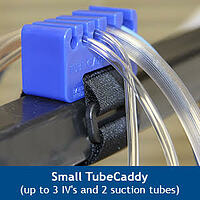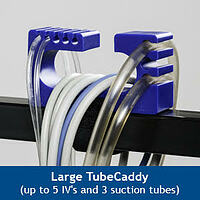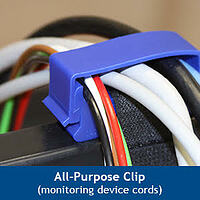TubeCaddy® Frequently Asked Questions (FAQs)
-
How is the TubeCaddy classified?
-
Why should I clean and disinfect noncritical reusable medical equipment?
-
How should I clean and disinfect noncritical reusable medical equipment?
-
How should I clean and disinfect the TubeCaddy?
-
How should I clean and disinfect Velcro used in medical equipment?
-
Which disinfectants can be safely used to clean and disinfect the TubeCaddy?
 |
 |
 |
How is the TubeCaddy classified?
The TubeCaddy is not a medical device, but is most closely similar to items classified as noncritical reusable medical equipment. According to the CDC, “virtually no risk has been documented for transmission of infectious agents to patients through noncritical items when they are used as noncritical items and do not contact non-intact skin and/or mucous membranes”. Other examples of noncritical reusable medical equipment / noncritical patient-care items are bedpans, blood pressure cuffs, crutches and computers.
Why should I clean and disinfect noncritical reusable medical equipment?
Preventing infection throughout patient care saves lives and money, and your patients are trusting in your ability to keep them safe while in your care. Diligence in cleaning, disinfecting, and where appropriate, sterilizing, has become increasingly important. Refer to the CDC Isolation Guideline for additional information. Contact us at (800) 338-4237 if you have any further questions regarding the safe use of TubeCaddy products.
How should I clean and disinfect noncritical reusable medical equipment?
The CDC Isolation Guideline recommends that “noncritical equipment contaminated with blood, body fluids, secretions, or excretions be cleaned and disinfected after use.“
The same guideline recommends that, in addition to cleaning, disinfection of bedside equipment is indicated for certain pathogens, which can survive in the inanimate environment for prolonged periods. Noncritical medical equipment surfaces should be disinfected with an EPA-registered low or intermediate-level disinfectant. Use of a disinfectant will provide antimicrobial activity that is likely to be achieved with minimal additional cost or work.
How should I clean and disinfect the TubeCaddy and Velcro in medical devices?
The TubeCaddy is comprised of polypropylene plastic and a Velcro strip. TubeCaddy manufacturer, Whitney Medical Solutions™, recommends that users follow their facility's existing procedures for cleaning and disinfecting plastics such as polypropylene and hook-and-loop style straps such as Velcro.
- The Winnipeg (Canada) Regional Health Authority recommends that Velcro be cleaned by removing lint and soaking in a hospital-approved disinfectant, followed by allowing the strap to dry completely.
- The Velcro Product Care Guide recommends using a stiff brush or another piece of hook to remove lint, and advises that the hook portion should be covered at all times so it does not grab onto anything it should not, preventing debris collection. Engaging the hook and loop before washing is also recommended.
Which disinfectants can be safely used to clean and disinfect the TubeCaddy?
Manufacturer testing through Whitney Medical Solutions, has shown that the TubeCaddy can withstand soaking in common disinfectants such as 91% Isopropyl Alcohol, 10% Chlorine Bleach and common Quaternary Ammonium Compound disinfectants for over 72 hours without adverse effect, except for a moderate reduction in "grip" of the Velcro strap, (that occurs even with water). For specific disinfectants, Whitney Medical Solutions recommends testing before use.
